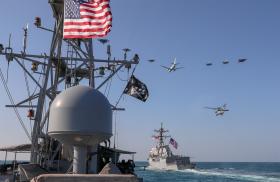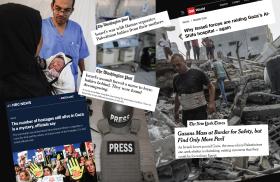On April 16, 2004, Jeffrey White and Michael Knights addressed The Washington Institute's Special Policy Forum, along with Michael Eisenstadt. Mr. White, an associate of the Institute, previously headed the Defense Intelligence Agency's Regional Military Assessments Group and Office for Middle East-Africa Regional Military Assessments. Dr. Knights, the Institute's Mendelow defense fellow, wrote his doctoral dissertation at King's College, London, on U.S. airstrikes in Iraq during and since the 1991 Gulf War. The following is a rapporteur's summary of their remarks. Read a summary of Mr. Eisenstadt's remarks.
JEFFREY WHITE
Fallout in Fallujah
The insurgency in Fallujah that began on April 6 (in response to the slaying and mutilation of four American contractors) was one of the most sustained fights of the Iraq war and ensuing occupation. A pinnacle in resistance activity, the siege of Fallujah pitted U.S. and coalition forces against a multifaceted and highly complex enemy wielding such tactics as hit and run, sniping, rocket-propelled grenade (RPG) firing, and ambushes. Harbingers like the three-and-a-half-hour gun battle in Samarra on November 30 between 100 insurgents and the 4th Infantry division -- as well as several other incidents around Fallujah in February -- demonstrated the prowess of the resistance and its growing capabilities. Coalition commanders planned for a short, precise operation in Fallujah against limited resistance. Instead, the coalition and the Iraqi resistance fighters battled to a stalemate after three days of intense fighting in which the insurgents exhibited coordination, the ability to engage in an urban environment, and the willingness to utilize civilians and mosques for cover. In short, the battle in Fallujah demonstrated that the resistance is neither on its knees nor broken.
Al-Sadr's Uprising
In conjunction with troubles in Fallujah, U.S. and coalition forces face the challenge of Muqtada al-Sadr and his Mahdi Army. The simultaneous, coordinated attacks initiated by al-Sadr on April 4 in Baghdad, Kufa, Kut, Najaf, portions of Karbala, Nasariyah, Hillah, Basra, and other locations indicate that the insurrection was clearly planned in advance. The myriad tactics in the militia's repertoire have included directing attacks with machine-gun and RPG fire against coalition headquarters and buildings, laying siege to local government buildings and police stations, liberating insurgents held in coalition detainment facilities, and taking hostages. The high tide of the Mahdi Army's activities was the April 7 fall of Kut and the humiliating retreat of Ukrainian forces stationed there, which resulted in the capture of Ukrainian armaments and facilities. However, al-Sadr's forces were not successful in either taking or holding positions when faced with a high-quality, aggressive coalition force opponent. The military sustainability of al-Sadr's militia -- keeping the force active, operating, and firing in the absence of a sound logistical base -- is also questionable.
MICHAEL KNIGHTS
New Iraqi Security Forces
Neither the new Iraqi security forces nor certain multinational forces are yet able to handle civil emergencies and resistance on the scale recently encountered -- a reality clearly reflected by U.S. plans to increase force levels in Iraq. During recent fighting in Fallujah and the Shi'i south, Iraqi Police Service (IPS) and Iraqi Civil Defense Corps (ICDC) personnel were confronted by a dangerous operational environment and a severe test of loyalty. In the south the multinational forces did not attempt to deploy the ICDC, while the IPS was either passive or complicit in the fighting, allowing the Mahdi Army to capture police stations, weapons caches, and vehicles. These benchmarks indicate that the fledgling Iraqi forces need to be built over time; prematurely exposing them to serious fighting may stress their sectarian and religious loyalties before a more secure Iraqi national identity can be reestablished under a sovereign government. The coalition needs to increase the mentoring and training of Iraqi forces with the help of additional international police officers and foreign trainers, and speed up the disbursement of U.S. and Iraqi funding to provide equipment for these forces.
Multinational Division Forces
A rather mixed performance has been exhibited thus far by the two multinational divisions stationed in southeast and south-central Iraq, respectively. The British-commanded division in the southeast managed to weather Mahdi Army attacks well, using force and negotiation to quash insurgencies. The Polish-commanded division in south-central Iraq, however, failed to defend key points and respond to direct attacks on Coalition Provisional Authority (CPA) compounds. Incidents like the Ukrainian withdrawal from Kut will likely minimize Iraqi respect for some multinational division troops, making it difficult to continue using those troops in a security role -- particularly in training new Iraqi security forces. Lack of troop cohesion was one source of weakness in the Polish-led division, where troops hail from twenty-three countries and speak seventeen languages. But the poorer performance of this division can also be attributed to contingent commanders phoning their own governments for tactical guidance instead of calling the Polish divisional commander. The restrictive guidance given by these national governments prevented troops from attempting to recover locations occupied by Mahdi Army militiamen, and even restrained them from defending themselves and the CPA compounds they inhabited. A new UN resolution and a larger role for NATO should allow multinational contributors to place their troops fully under coalition command and control, operating as part of a NATO-led division. The United States can also do more to share lessons learned with those international troops currently serving in Iraq or being pledged for future service there.
This Special Policy Forum Report was prepared by Bjorn Delaney.
Policy #861




